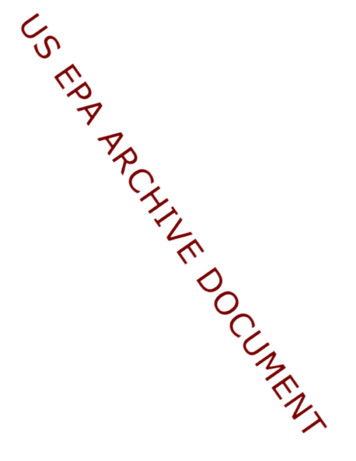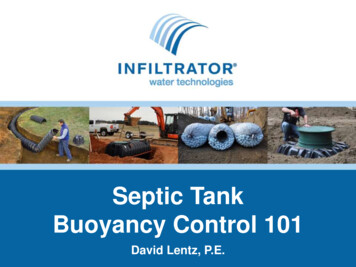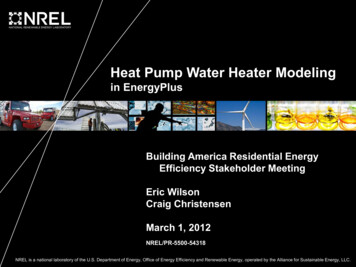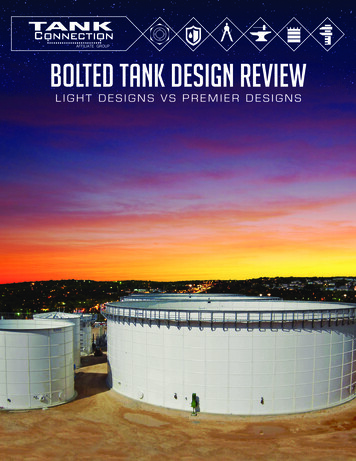
Transcription
Confusion for Tank Owners: When Integrity Testing Finds TankDeficiencies Not Directly Referenced in the SPCC RuleBy Ed Fahnline, P.E.,URS CorporationApril 2006ABSTRACTAs consulting engineers working on Spill Prevention, Control, and Countermeasure (SPCC) Plansand tank design projects, we have encountered a number of oil tanks since 2002 for which ownershave received certified tank integrity inspections citing numerous tank deficiencies not directlyreferenced in 40 CFR part 112.The citations were commonly associated with fire codes.Examples of these tank deficiencies include insufficient venting, venting indoors, inadequate tanksupport, and tank placement. These issues, while identified within industry guidance such asNational Fire Protection Association (NFPA) 30, can be a surprise to tank owners who thought thepurpose of the tank integrity testing was to ensure that the tanks meet spill requirements such assecondary containment, structural integrity, and overfill protection.This paper addresses the confusion of tank owners when finding out that their tanks passed thestructural integrity tests but were still out of compliance due to issues such as venting and tanklocation. The intent of this paper is threefold: Inform tank owners of the relationship between federal, state, and local regulations andindustry guidance.1
Describe the confusion that tank owners may have when integrity testing discovers tankdeficiencies not discussed in the SPCC Rule. Encourage companies that prepare SPCC Plans and perform integrity testing to more fullyexplain the relationship between the integrity test industry guidance they must adhere to andfederal, state, and local regulations.OVERVIEW OF REGULATIONSThe regulation of oil-containing aboveground storage tanks (ASTs) is a function of federal, state,and local governments. The regulations generally focus on environmental issues such as oil spillprevention and fire prevention.One area of confusion is the concept of “environmental”requirements versus “fire code” requirements for oil storage containers. This paper refers to theseterms in a general sense because there is overlap between the two fields. A tank leak is generallyconsidered an environmental issue, but it could also lead to oil reaching an ignition source. A tankwith insufficient emergency venting capacity is both a fire hazard and an environmental spill risk ifthe tank ruptures from over-pressurization. The unclear overlap of environmental and fire coderequirements are a source of confusion and provide the backdrop of this paper.Provided below is a summary of government regulations and industry standards.Federal Governmental RegulationsThe two primary federal codes addressing oil-containing ASTs are 29 CFR part 1910 (§1910.106)and 40 CFR part 112 (§112), which is often referred to as the SPCC Rule. The SPCC Ruleaddresses oil pollution prevention for oil containers, while §1910.106 addresses the Occupational2
Safety and Health Administration (OSHA) standards for flammable and combustible liquids.Section 112 requires the development and implementation of an SPCC Plan for non-transportationrelated facilities that have aboveground storage capacity greater than 1,320 gallons of petroleumbased products (e.g., oil)1 in containers that hold 55 gallons or more, and could reasonably beexpected to discharge oil in quantities that may be harmful into or upon the navigable waters of theUnited States. SPCC Plans are discussed in more detail in the next section. The OSHA regulationis applicable to any business with containers storing materials covered by §1910. This includesmany types of petroleum products based on flammability and combustibility definitions, includinggasoline and diesel fuel.State Governmental RegulationsAST regulations vary from state to state, but generally address tank installation and registration (iftank or facility capacity is above a threshold), inspections, spill containment, release reporting,corrective action procedures, and tank closure requirements. The regulations typically cover fireprevention and environmental issues. Depending on the state, the AST regulations are eithercodified together under one AST subchapter, or codified separately under a fire preventionsubchapter and an environmental management subchapter.Local Governmental RegulationsMany local governments also have oil-containing AST requirements. The fire marshal is usuallythe responsible party within the local government. It is important to note the critical role that stateand local fire marshals have in enforcing fire codes.1Oil will hereafter refer to all petroleum-based products covered under the SPCC rule.3
Industry Standards and CodesIt is common for industry standards to be partially or wholly adopted by state or local governmentoil control programs. The standards themselves are not legally enforceable unless adopted orreferenced by an applicable government regulation. In addition, an industry guidance referencedby an SPCC Plan or other tank engineering document (e.g., tank installation specifications) must beadhered to.Industry standards are available for fabrication, installation, operation, and inspection of oilcontaining ASTs.2 Some of the more commonly referenced industry standards include:Fire prevention issues: NFPA 1, Uniform Fire Code NFPA 30, Flammable and Combustible Liquids International Code Counsel (ICC), International Fire CodeTank fabrication, installation, and testing American Petroleum Institute (API) 650, Welded Steel Tanks for Oil Storage Underwriters Laboratories (UL) 142, Steel Aboveground Tanks for Flammable andCombustible Liquids UL 2080, Standard for Fire Resistant Tanks for Flammable and CombustibleLiquids UL 2085, Standard for Protected Aboveground Tanks for Flammable andCombustible Liquids2The term industry standard will hereafter be used to refer to industry standards, codes, and recommended practices.4
Tank and associated piping inspection Steel Tank Institute (STI) SP001, Standard for the Inspection of AbovegroundStorage Tanks API 653, Tank Inspection, Repair, Alternation, and Reconstruction API 570, Piping Inspection Code, Inspection, Repair, Alternation, and Rerating ofIn-Service Piping Systems API RP 575, Inspection of Atmospheric & Low Pressure Storage TanksSPCC PLANSOn December 11, 1973, the Environmental Protection Agency (EPA) first issued regulationsestablishing procedures, methods, equipment, and other requirements to prevent the discharge of oilfrom non-transportation-related onshore and offshore facilities into or upon the waters of theUnited States. The regulations are identified as 40 CFR part 112, revised 1987, “Oil PollutionPrevention; Non-Transportation-Related Onshore and Offshore Facilities.” On October 22, 1991,the EPA published proposed rules including further revisions. A new revision of the SPCC rulewas published in the Federal Register on July 17, 2002 and became effective August 16, 2002. TheEPA published a final rule amending the SPCC rule in the Federal Register on February 17, 2006.This action extends the SPCC compliance dates (revise Plan and implement Plans) in §112.3(a),(b), and (c) for all facilities until October 31, 2007.The primary purpose of the SPCC Rule is spill prevention, but Part 112(7)(j) requires that the Planinclude a discussion of conformance with the applicable state rules, regulations, and guidelines.Because most states have fire prevention regulations for ASTs, the Professional Engineer (P.E.)preparing the SPCC Plan should consider the applicability of the state fire code.5
COMPLIANCE OF OIL TANKS WITH FIRE CODE REGULATIONSBased on the number of documented tank failures, discussions with regulatory and industry entities,and project tank experience; there is a potentially significant number of aboveground tank systemsthat have deficiencies with respect to regulatory or industry standards. These tank deficiencies aredue to a variety of causes such as structural integrity failure, improper installation, tank placement,poor maintenance, and missing or broken tank equipment. Figure 1 presents an example ofrequired equipment for a U.L. 142 double-wall tank. Figure 2 presents a photo of an installed U.L.2085 tank with dual dispensers and a fuel management system.The revised SPCC Rule appears to have resulted in greater awareness of oil AST environmentalissues spill containment, security, overfill alarms, and tank inspections. However, oil tank ownersFigure 1Typical U.L. 142 Double-wall Aboveground Storage Tank6
Photo courtesy of Core Engineered SolutionsFigure 2Dual Compartment Convault Protected AST (U.L. 2085)and SPCC Plan preparers may be less aware of fire code issues with which tanks must comply. Inour experience, tank deficiencies are usually discovered one of the following ways: Tank failure or other emergency Tank inspection by government inspector Certified integrity inspections per the SPCC Rule or state regulations Tank evaluation as part of a facility Environmental Site Assessment, tank registration, tankrepair/upgrade, or SPCC Plan preparationThe large number of SPCC Plan revisions and certified inspections to be performed over the nextseveral years should be a significant route through which fire code deficiencies are discovered. Thenext section describes tank inspections in detail.7
TANK INSPECTIONSA critical component of any oil tank program is inspection, including integrity testing inspections.As discussed below, integrity testing (visual inspection combined with another testing technique)for aboveground bulk storage containers will be required by the SPCC rule when the compliancedate arrives in 2007. Currently, an operator may opt to use visual inspection alone. However, thereare many issues within the scope of integrity testing that relate to fire code deficiencies. Presentedbelow is an overview of integrity testing regulations and industry guidance.Federal (this requirement is not in effect until October 31, 2007)Under §112.108(c)(6), for bulk storage containers the owner must “Test each abovegroundcontainer for integrity on a regular schedule, and whenever you make material repairs. Thefrequency of and type of testing must take into account container size and design (such as floatingroof, skid mounted, elevated, or partially buried). You must combine visual inspection withanother testing technique such as hydrostatic testing, radiographic testing, ultrasonic testing,acoustic emissions testing, or another system of non-destructive shell testing. You must ”Page 47119 of the July 17, 2002 Federal Register provides an analysis of §112.108(c)(6). It definesintegrity testing as “any means to measure the strength (structural soundness) of the containershell, bottom, and/or floor to contain oil and may include leak testing to determine whether thecontainer will discharge oil. It includes, but is not limited to, testing foundations and supports ofcontainers ” This analysis also states that industry standards may assist an owner or operator withintegrity testing.8
On December 2, 2005, EPA released the SPCC Guidance for Regional Inspectors. The document isintended to assist regional inspectors in reviewing a facility's implementation of the SPCC Rule.Section 7 of the EPA Guidance provides detailed information on inspections and integrity testing.EPA provided examples of environmentally equivalent protection for certain tanks with regard tointegrity testing as required in the 2002 SPCC Rule. As discussed in the March 2004 EPAdocument EPA Settlement Issues, for shop-built containers with a shell capacity of 30,000 gallonsor less, combining visual inspection with either (1) elevation of the container in a manner thatdecreases corrosion potential and makes all sides of the container visible, or (2) placement of anon-permeable barrier between the container and ground, would be considered equivalent to nondestructive testing methods. For tanks that meet these conditions and where a P.E. has made anenvironmental equivalence determination, the P.E. can determine the appropriate method ofintegrity testing that is needed to meet the standard of good engineering practices. For example, theP.E. must decide whether a rectangular, double-wall tank sitting on the ground meets the criteria,even if the outer tank floor cannot be inspected and may corrode over time. However, the decisionmaking process should be rooted in best management practices, including industry standards. At aminimum, periodic visual inspections are needed by a qualified inspector. The P.E. must decide ifcertified inspections are needed.It is important to note that regardless of the facility’s oil-containing capacity, only a P.E. can makean environmental equivalence determination. Therefore, the December 12, 2005 EPA proposedSPCC amendment of self-certification for facilities with less than 10,000 gallons of oil storagecapacity would not allow for equivalent protection in place of certified integrity testing.9
In summary, under the new SPCC Rule, bulk oil containers will need certified integrity testing oran environmentally equivalent method (as discussed above). The scope and interval of the certifiedintegrity testing will depend on factors such as tank type, configuration, age, and condition. If nobaseline data on the tank is available, Section 7 of the SPCC Guidance for Regional Inspectorsstates that, initially, more frequent integrity testing may be needed. The suitability of a tank (withno baseline data) for continued service can be determined from certified inspections using guidancein API 653 or STI SP001. In addition, all bulk storage containers lacking secondary containmentand for which an impracticability determination has been made must have certified integrity testing.State/LocalOn the state/local level, integrity testing regulations are in some cases more stringent than §112 andmust be followed as applicable. It is important to note that site inspections by state and localinspectors and fire marshals will likely focus on both environmental and fire code issues.Industry GuidanceWhen the SPCC Plan states that a certified inspection is required, the inspector must perform theinspection in compliance with the standards referenced in the Plan. Three of the most commonlyused inspection guidance documents are API 653, API 570, and STI SP001. Note, the latestrevision of STI SP001 (July 2005) contains major revisions from the 2003 version.Section 5 of STI SP001 provides an inspection schedule. The inspection intervals and scope arebased on the tank size and configuration. For instance, STI SP001 does not require formal certifiedinspections for elevated tanks 5,000 gallons or less if complete visual inspection is possible and the10
tank has secondary containment. Formal external inspections and a leak test, both performed by acertified inspector, should be conducted at least every 10 years for a single-wall tank sized 1,101 to5,000 gallons in contact with the ground but with spill control (STI-SP001, July 2005).3 All ASTssized above 5,000 gallons require a formal external inspection every 5 to 20 years, with the timeinterval depended on the tank size and configuration.API 653 and API RP 575 both require certified inspections based on a tank’s service history withcertified inspection intervals of 5 to 20 years depending on the tank size and configuration.Performance of a certified inspection requires the specialized experience of personnel certified bythe Steel Tank Institute or the American Petroleum Institute. An STI- or API-certified tankinspector must perform the inspection per the guidance for which they are certified. Both the STIand API guidance require that the integrity inspection include the evaluation of many aspects of thetank and its equipment to address tank integrity, secondary containment, spill prevention, and firecode related issues. Section 7 of SP001 contains the minimum inspection requirements for formalexternal inspections that must be conducted by a certified inspector. Integrity testing includeshydrostatic techniques, visual inspections, non-destructive shell-thickness testing, or a combinationof these methods based on equipment design. The tank foundation and supports are included in thetesting. SP001 states that inspections should cover the AST secondary containment, drain valves,ancillary equipment, piping, vents, gauges, grounding system, stairways, and coatings.Theinspector examines these tank components according to the industry guidance to which it wasdesigned, such as UL 142 or API 650.3The reader should refer to these standards; this information for discussion purposes only.11
COMMON TANK DEFICIENCIESTank deficiency regulatory citations that arise from government inspections or integrity testingcould be referenced from §112, §1910.106, state/local regulations, or industry standards. Havingestablished the relationship between the regulations and industry standards, this section providesexamples of potential tank deficiencies. Common deficiencies are presented below and groupedunder environmental issues and fire code issues. However, many of the environmental issues couldlead to fire hazards and the fire code issues could lead to a spill. Note some of these issues may notbe applicable depending on the tank placement, stored oil classification, and State/local regulations.Environmental Issues: Failure of structural integrity or Evidence of leak / overfilltightness test Broken tank gaugeMalfunctioning overfill or leak No spill controldetection alarms Tank equipped with improper fittingsNo or undersized secondary No integrity test program or baselinecontainment for tank or piping tank dataGeneral surface corrosion/paint failureFire Code Issues: Tank or pipe unprotected from No groundingdamage by vehicular traffic No emergency vent Not anchored to floor/foundation Vent/vent pipe not adequately sized Tank support structure inadequate Vent shared by two tanks Venting indoors Pipe not properly supported12
Fire Code Issues (continued): Support legs of tank too long Tank too close to adjacent tank Combustible material (trash, leaves)in the dike areaTANK OWNER CONFUSION AND POTENTIAL CONSEQUENCES OF TANKDEFICIENCIESEPA estimates that 618,000 facilities are currently regulated under the SPCC Rule (EPA, SPCCGuidance for Regional Inspectors, 2005). Once an SPCC Plan has been developed and signed by aP.E., the next step is for the owner / operator to implement the Plan in order to be in compliancewith the SPCC Rule. This may include tank system upgrades, such as new secondary containmentand tank alarms, as well as employee training and integrity testing. As discussed previously inTank Inspections, formal certified inspections are required when specified by the facility SPCCPlan. However, because fire code issues are not generally discussed in SPCC Plans, there may beno expectations on the part of the tank owner that fire code issues are relevant. The result is thatthe tank owner is making cost and schedule decisions based on incomplete understanding of all thetank upgrades that may be needed. The problems for a tank owner whose tank does in fact havefire code type deficiencies are discussed in more detail below.Incorrect expectations and confusion concerning integrity testing: Many SPCC Plans may lacksufficient detail about integrity testing to allow a clear understanding of the tests to be performedby the certified inspector. The simple fact that the certified inspection requires more than just astructural integrity test may be a surprise to many tank owners. A certified inspection report islikely to discuss tank deficiencies in terms of industry codes but may not provide a direct link13
between the applicable regulations and the industry standard which covers the actual deficiency. Areport that does not explain why the upgrades must be performed leads to confusion and questionsconcerning the legal necessity to install the upgrades. This is especially true for deficiencies notdirectly referenced in §112. An inability to clarify the regulatory authority for upgrades can beespecially problematic for the employee tasked with SPCC implementation.Potential tank failure: A tank with deficiencies such as insufficient emergency venting capacity orno grounding is a fire hazard. A generator tank that fails to supply fuel to the generator could resultin loss of backup power during a power outage. The cost for AST upgrades is typically a fractionof the cost for spill response and clean-up of an oil spill. A tank fire or loss of backup power is animmediate risk to personnel.Possible fines from government inspections for fire code violations: If the fire code deficienciesare discovered during a government inspection, it is possible that fines will be administrated(especially if the problems are not quickly resolved). Tank installation and upgrade work is aspecialty field dominated by small businesses. In the mid-Atlantic region, tank contractors havebeen very busy the last several years due to new development, UST removals, and tankreplacements. Tanks and tank components are periodically in short supply and usually requireseveral weeks for delivery. Being forced to upgrade a tank system immediately to avoid fines canplace significant stress and increased costs on a tank owner. In addition, fines and code violationsmay cause increased premiums or cancellation of an owner’s tank insurance. An insurance carrieris likely to reject a claim for a tank that has outstanding fines or code violations.14
Underestimated and inefficient spending for tank upgrades:Having an understanding of thecomplete cost for tank upgrades helps a tank owner better plan for expenditures and allows formore effective use of funds. In some cases, the decision to upgrade a tank or replace it couldchange based on additional upgrades required to meet fire codes. Many tank owners have differentfunding mechanisms for environmental versus fire code issues and having a sense of all theproblems up front can help with funding strategy.COSTS FOR TANK UPGRADE COMPARED TO INSTALLATION OF NEW TANKAs discussed above, in some cases, the decision to upgrade a tank or replace it requires anunderstanding of all deficiencies. Presented below are typical estimated costs for tank repairs andtank replacement. For reference, the cost to perform a certified external integrity test (assumesultrasonic thickness test) and produce a report for a 500-gallon tank and associated piping can oftenrange between 800 to 1,500.The costs presented herein are approximate and based on industryunit cost literature, vendor cost lists, and professional experience.Tank Replacement: The cost to remove of an outdoor 500-gallon AST that failed a tightness testand replace it with a new 500-gallon double-wall steel AST is approximately 11,000 to 15,000.15
Tank Repairs: The estimated cost to install new tank equipment or make tank repairs is presented inthe table below for an outdoor 500-gallon steel AST.- Install 5-gallon spill bucket 500- Install 2-inch diameter automatic shut-off overfill protection valve 1,150- Install 2-inch visual tank clock gauge 630- Install bollard (each) 650- Anchor tank to floor / foundation 520- Install grounding cable for tank 550- Install 4-inch diameter emergency vent 330- Install pipe support (each) 300CONCLUSIONThe intent of this paper is to explain the relationship between regulations and industry guidance foroil-containing ASTs in terms of both environmental issues and fire prevention codes. The revisedSPCC Rule appears to have resulted in greater awareness of the environmental issues for oilcontaining ASTs.Certified inspections should be a significant route through which tankdeficiencies are discovered. However, a general understanding of fire code issues during the SPCCPlan stage will better enable owners to address tank deficiencies and thus avoid subsequentproblems. Specific actions that could help address these issues are provided below.1. It should not be assumed that the majority of tank owners and SPCC Plan preparers are aware ofhow fire prevention issues relate to actions driven by environmental regulations (i.e., integritytesting). Government agencies, industry associations, and trade groups play a significant role inalerting their members to tank issues and are in a position to disseminate the most up-to-dateinformation.16
2. Professional Engineers developing SPCC Plans should have at least a basic understanding of firecode regulations relevant for a facility. In our experience, clients are in a much better position toaddress tank upgrade requirements when alerted to the potential environmental and fire codedeficiencies during the SPCC Plan process. Of course, Plan developers should know when to referthe tank owner to a certified tank inspector. However, alerting the client to potential fire codeissues would in many cases be appropriate. Problems such as a lack of emergency venting, ventingindoors, and tanks situated too close to each other can be pointed out as potential problems.3. SPCC Plans need sufficient information about integrity testing to allow a clearer understandingof the required scope of work that will be performed by the certified inspector. This will also givethe owner a better idea of what to expect and provide a more concise scope of work for theinspector. The EPA SPCC Guidance for Regional Inspectors and the latest versions of STI SP001and other standards provide useful guidance for the Plan preparer.4. Companies that perform certified integrity testing should explain to their clients the relationshipbetween the integrity test industry guidance they must adhere to and federal, state, and localregulations.AUTHOR CONTACT INFORMATIONEd Fahnline, P.E.URS Corporation, Gaithersburg, MDPhone: 301-258-9780E-mail: ed fahnline@urscorp.comACKNOWLEDGMENTSMy thanks to Jeff Hutchins, P.E. of URS Corporation for his technical review of this paper.17
This paper was written for presentation at the Sixth Biennial Freshwater Spills Symposium, May2006.REFERENCESAmerican Petroleum Institute (API) 650, Welded Steel Tanks for Oil StorageAPI 653, Tank Inspection, Repair, Alternation, and ReconstructionAPI 570, Piping Inspection Code, Inspection, Repair, Alternation, and Rerating of In-ServicePiping SystemsAPI RP 575, Inspection of Atmospheric & Low Pressure Storage TanksInternational Code Counsel (ICC), International Fire CodeNational Fire Protection Association (NFPA) 1, Uniform Fire CodeNFPA 30, Flammable and Combustible LiquidsSteel Tank Institute (STI), SP001, Standard for the Inspection of Aboveground Storage TanksUnderwriters Laboratories (UL) 142, Steel Aboveground Tanks for Flammable and CombustibleLiquidsUL 2080, Standard for Fire Resistant Tanks for Flammable and Combustible LiquidsUL 2085, Standard for Protected Aboveground Tanks for Flammable and Combustible LiquidsUnited States Environmental Protection Agency (USEPA), 40 CFR part 112: Oil PollutionPrevention and Response; Non-Transportation-Related Onshore and Offshore FacilitiesEPA SPCC Guidance for Regional Inspectors, December 2, 2005EPA Settlement Issues, Oil Program Staff, March 31, 2004U.S. Department of Labor, Occupational Safety and Health Administration (OSHA), 29 CFR1910.106: Occupational Safety and Health Standards; Flammable and Combustible Liquids18
Dual Compartment Convault Protected AST (U.L. 2085) and SPCC Plan preparers may be less aware of fire code issues with which tanks must comply. In our experience, tank deficiencies are usually discovered one of the following ways: Tank failure or other emergency Tank inspection by government inspector










